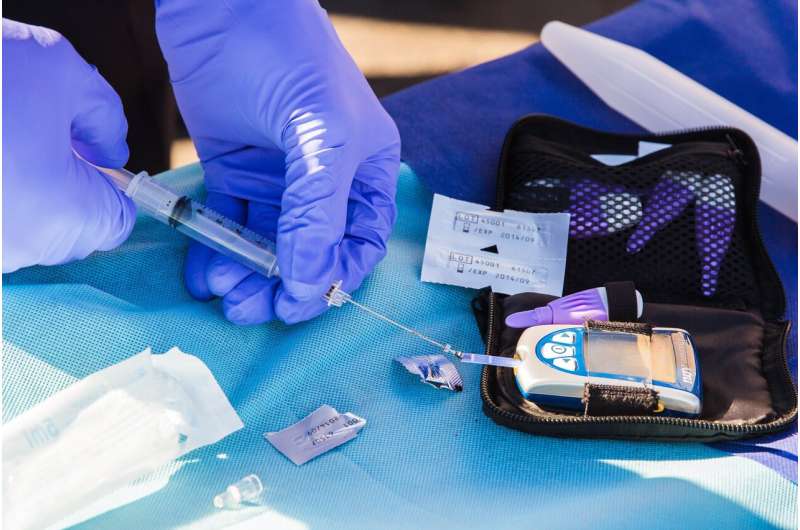This article has been reviewed according to Science X's editorial process and policies. Editors have highlighted the following attributes while ensuring the content's credibility:
fact-checked
trusted source
proofread
First-of-its-kind analysis gives more precise insight into factors driving up costs for type 2 diabetes patients

A new study appearing in BMC Health Services Research from the Texas A&M University School of Public Health suggests that high A1C values, diabetes complications and other comorbidities lead to higher type 2 diabetes overall costs and greater likelihood of cost increases over time. This is especially the case for patients living in rural areas.
About 37 million Americans—more than 1 in 10—had diabetes in 2021, and that number is growing. In fact, diabetes in the United States has more than doubled in the last 20 years, largely due to an increase in obesity and an aging population. More than 90% of those diagnosed have type 2 diabetes (T2D).
The problem is especially acute in Texas, where 12.9% of the population (2.7 million Texans) had diabetes in 2019, compared to 10.9% of all Americans. The annual cost of diabetes and prediabetes in Texas has been estimated at $25.6 billion.
The study was part of the Texas A&M Rural Moonshot Initiative sponsored by Blue Cross and Blue Shield of Texas (BCBSTX). Lead researchers were Gang Han, Ph.D., professor in the Department of Epidemiology and Biostatistics, and Marcia Ory, Ph.D., Regents and Distinguished Professor in the Department of Environmental and Occupational Health. Others on the research team from Texas A&M were Matthew Smith, Elena Andreyeva, Lixian Zhong and Keri Carpenter.
The study results provide a better understanding of the cost trajectories associated with diabetes in Texas, thanks to the novel use of statistical analysis software.
"The growing burden of diabetes makes it even more important for health care professionals and others to understand how diabetes patients use health care and the costs involved," Ory said. "Our findings should help people manage diabetes, or even prevent it."
The research focused on the cost trajectories experienced by different groups of Texans with diabetes, such as those with higher A1C levels—which are identified through a blood test that measures one's average blood sugar levels over the past three months in order to diagnose or determine proper treatment—using statistical analysis software.
While previous studies also have used comparable approaches, Han said there is a potential flaw in interpreting their findings: They ignored the fact that these patients differ from each other except for the fact that they have diabetes.
"For example, at any A1C level, some patients may have increased cost over time, while others may have relatively stable costs at low and high levels," Han said. "In addition, other features in the dataset can result in a high amount of 'noise' that hinders the statistical model's ability to identify clinically significant factors."
The researchers analyzed data on Texas insurance claims issued by a large commercial insurer from 2016 to 2019. They implemented group-based trajectory modeling—a mixture of models for estimating developmental trajectories—in a procedure known as "Proc Traj" in the statistical analysis software (SAS).
"The group-based trajectory analysis can classify different patterns of change over time and has been utilized to analyze projected costs," Han said. "But we believe we are the first to use it to identify and analyze clusters of patients based on the patterns of their cost changes over time, which provided new insights into the pattern of changes in cost for patients with T2D."
The group-based trajectory analysis found distinct patient groups with increased cost and stable cost at low, medium and high levels in the period studied. The trend of T2D-related costs over the four years fell into three categories: patient demographics, clinical factors (such as A1C levels and short- and long-term complications) and patient residency in rural areas.
The study found significant associations between the trend of cost and A1C, complications and rurality, which could have important implications for the development of policies and programs to improve health outcomes and contain health care costs.
"The results of this study reinforce why early identification and management of diseases, such as diabetes, are so important," said Mark Chassay, MD, BCBSTX vice president and chief medical officer. "We want to encourage Texans to forge a relationship with their primary care physician and regularly use preventive care to maximize not only their health care dollars, but also their optimal health outcomes."
More information: Gang Han et al, Group-based trajectory analysis identifies varying diabetes-related cost trajectories among type 2 diabetes patients in Texas: an empirical study using commercial insurance, BMC Health Services Research (2023). DOI: 10.1186/s12913-023-10118-1




















